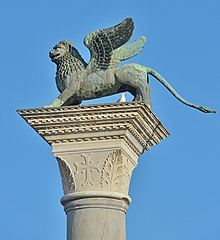威尼斯之狮
外观
(重定向自威尼斯狮子)
| 威尼斯之狮 | |
|---|---|
 威尼斯之狮 | |
| 艺术家 | 未知 |
| 年份 | 600年至900年(有争议) |
| 类型 | 青铜 |
| 收藏地 | |


威尼斯狮子是一个古老的青铜翼狮雕塑,位于意大利威尼斯的圣马可广场,重约3,000公斤。它是威尼斯城市的象征,也是威尼斯的主保圣人圣马可的象征。
这尊雕塑位于广场上的双柱圣马可和圣托达洛柱中一根柱子的柱顶,据认为竖立于1172-1177年,总督塞巴斯蒂安·齐亚尼统治期间[1], 或约1268年[2]。 对其青铜合金的铅同位素分析证明,其材料来源于长江中下游流域,且很可能铸于唐代,但具体何时、如何抵达威尼斯仍不得而知。另外从风格上看,该雕塑也与唐代典型的镇墓兽有共同的特征。[3][4]
数世纪以来,狮子经历了多次修复。17世纪90年代,拿破仑劫掠了这座雕塑并将其运往巴黎,1815年运回威尼斯时遭到损坏,后由威尼斯雕塑家Bartolomeo Ferrari修复,在保留大部分原始结构的同时,在雕塑的前爪下增加了一本铅制的书。[3]
参考
[编辑]- ^ Madden, Thomas F., Venice: islands of honor and profit: a new history (2012), Penguin Books, p. 98.
- ^ Maguire, Henry and Robert S. Nelson, editors (2010), San Marco, Byzantium and the Myths of Venice (Dumbarton Oaks Byzantine Symposia and Colloquia); Dumbarton Oaks Research Library and Collection, pg 79 and note 10 on pg 10.
- ^ 3.0 3.1 Dario Radley. The Lion of St. Mark’s Square in Venice is Chinese: Isotopic Analyses Confirm It. Archaeology News. 2024-09-16 [2024-11-02].
- ^ Il leone di piazzetta S. Marco a Venezia è "Made in China" [威尼斯圣马可广场的狮子是“中国制造”]. Università di Padova. [2024-11-02] (意大利语).
